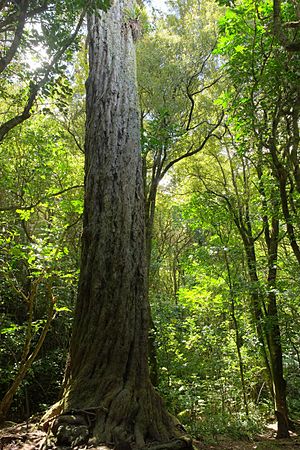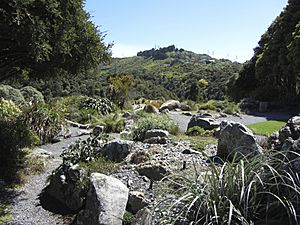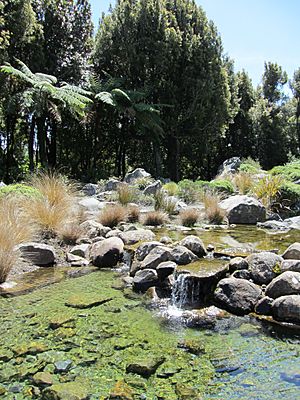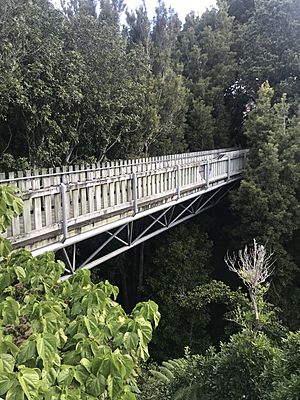Otari-Wilton's Bush facts for kids
Quick facts for kids Otari Native Botanic Garden and Wilton's Bush Forest Reserve |
|
|---|---|
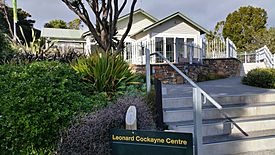 |
|
| Type | Native plant botanical garden |
| Location | Wellington, New Zealand |
| Area | 259.46 acres (105.00 ha) |
| Operated by | Wellington City Council |
| Species | ~1,200 |
| Website | https://wellingtongardens.nz/our-gardens/otari-wilton's-bush/ |
Welcome to Otari Native Botanic Garden and Wilton's Bush Reserve, often called Otari-Wilton's Bush! This special place in Wellington, New Zealand, is the only public garden in the country that focuses only on plants native to New Zealand. It's a fantastic spot to explore and learn about the amazing plant life found here.
Contents
- Discover Otari-Wilton's Bush: New Zealand's Unique Plant Sanctuary
- The Story of Otari-Wilton's Bush: From Forest to Garden
- Exploring the Native Botanic Gardens: A Living Collection
- Protecting New Zealand's Plants: Conservation Efforts
- The Forest Reserve: Old Trees and New Growth
- Fun Things to Do at Otari-Wilton's Bush
- Explore the Forest: Trails and Walking Tracks
- Amazing Animals: Fauna of Otari-Wilton's Bush
- Images for kids
Discover Otari-Wilton's Bush: New Zealand's Unique Plant Sanctuary
Otari-Wilton's Bush is a truly unique plant sanctuary and forest reserve. It covers 100 hectares (about 250 acres) of native forest. There are also five hectares of special plant collections. You can find some of Wellington's oldest trees here. One amazing example is an 800-year-old rimu tree!
This garden is so important that the New Zealand Gardens Trust has named it a Garden of National Significance. It was also one of the first gardens to be part of the Trust. The Wellington City Council owns and manages Otari-Wilton's Bush.
It's free to enter, and the garden is open every day from sunrise to sunset. The Te Marae o Tane Information Centre is open from 8:00 AM to 4:00 PM daily.
You can find Otari-Wilton's Bush just 5 kilometers from the city center. The address is 160 Wilton Road. You can drive and park at the main car park near the Wilton Road entrance. Or, you can take the No. 14 Wilton bus from Lambton Quay. There's also parking off Churchill Drive.
Many paths are easy to use for wheelchairs. These paths go from the main car park to the Information Centre. They also lead over the Canopy Walkway and to Cockayne Lookout. A path without steps goes from the Churchill Drive car park. It follows the Kaiwharawhara Stream to the Troup Picnic Lawn.
The Story of Otari-Wilton's Bush: From Forest to Garden
Long ago, Otari-Wilton's Bush was covered in thick native forest. The Māori name “Otari” means “Place of Snares.” This tells us it was a good place for hunting birds. When Europeans arrived, many trees were cut down for timber and to create farmland.
The first part of the reserve to be protected was a 7-hectare area. A farmer named Job Wilton fenced it off in 1860 to keep animals out. This area became known as Wilton’s Bush. In 1906, it officially became a scenic reserve. Over time, more parts of the forest were added to the reserve. This was done by the New Zealand Government and the Wellington City Council. These areas include the old podocarpaceae forest that once covered Wellington.
The forest has native trees that are hundreds of years old. You can see matai (Prumnopitys taxifolia) and rimu (Dacrydium cupressinum). There are also tawa (Beilschmiedia tawa), rewarewa (Knightia excelsa), and kohekohe (Dysoxylum spectabile).
The idea for the native botanic gardens came from a famous botanist, Dr. Leonard Cockayne. He started developing these plant collections in 1926.
Exploring the Native Botanic Gardens: A Living Collection
The plant collections at Otari-Wilton's Bush have about 1,200 different types of plants. These include species, hybrids, and special varieties. The plants come from New Zealand's main islands and smaller islands offshore.
Most of these plants grew from cuttings or seeds. These were collected from their original homes in the wild. The collection has several important jobs:
- Conservation: Young plants of threatened species are grown here. They are either kept in the gardens to protect them or planted back in the wild. This helps save them from disappearing.
- Research: Scientists use these plants to study how they grow and interact with nature. They also look into their possible uses and how to classify them.
- Education: Each plant has a label. This helps visitors learn their names and what makes them special.
- Recreation: Otari-Wilton's Bush is a wonderful place for everyone to visit. It's a peaceful escape from city life. You can enjoy and appreciate New Zealand's unique plants.
Dr. Leonard Cockayne, a famous New Zealand botanist, started the plant collections in 1926. His goal was to create a collection of only New Zealand native plants. He wanted to show them in groups by plant family or as mini-ecosystems. These would represent different areas of New Zealand.
The plants are arranged in different sections. These include an alpine garden, a fernery, and collections of hebe and flax. There's also a large rock garden, grass and sedge species, and a coastal garden.
Protecting New Zealand's Plants: Conservation Efforts
Many New Zealand plants in the Native Botanic Gardens are endangered in the wild. Some of these are grown here to help save them. They are either kept in the gardens or returned to their natural homes. This is part of plant conservation recovery programs.
When people settled in New Zealand, many plants disappeared. This happened in forests, wetlands, and along the coasts. Farming and logging caused big losses. Also, new animal pests and invasive weeds harmed the native plants.
Sadly, several New Zealand plants are already extinct. More than 180 plants are now classified as severely threatened.
The Forest Reserve: Old Trees and New Growth
The reserve has 100 hectares of forest. This includes both original old-growth forest and areas where the forest is growing back. A 17-acre section was set aside by Job Wilton in 1860. There's also a much larger area of forest that is regenerating.
The original forest has very large trees like rimu and rata. Some of these are thought to be between 400 and 800 years old! You can see large conifers, called podocarps, like rimu, totara, miro, and matai. You can view them from the Canopy Walkway or the Nature Trail.
About 150 types of flowering plants, conifers, and ferns live in the forest. Epiphytes, or "perching plants," grow high up in the branches of old trees. Climbing plants, like the New Zealand passionfruit, supplejack, and rata, are found throughout the forest. Kohekohe, rewarewa, tawa, and mahoe trees grow on the upper slopes. They mix with older rimu and matai trees. In wetter areas, you can see tall pukatea trees with their special buttressed roots.
On the high, south-facing slopes, you might see introduced gorse and Darwin’s barberry. Native plants like mahoe and rangiora are starting to grow there too.
Since 2001, staff and volunteers have planted thousands of trees. They are working to help the forest grow back faster. Their goals include making the area more diverse. They also want to encourage more native birds and insects to live there. Much of this work is done by volunteers from the Otari-Wilton's Bush Trust.
The regenerating forest started growing in the valleys. Now, it covers most of the reserve. It is slowly spreading up to the tops of the hills on the other side of the valley.
Fun Things to Do at Otari-Wilton's Bush
The Information Centre, called “Te Marae o Tane,” is a great place to start. It has information about New Zealand's plants and animals. You can also learn more about Otari-Wilton's Bush itself. The centre is open daily from 8 AM to 4 PM. It has displays, information, and seating for groups. You can even book a small lecture room for plant-related or educational events.
Walk Among the Treetops: The Canopy Walkway
Get ready for an adventure! A 75-meter-long canopy walkway starts at the Information Centre. It connects two main garden areas. The best part? It's 18 meters (about 60 feet) above the forest floor! You'll feel like you're walking among the treetops.
Explore the Forest: Trails and Walking Tracks
Otari-Wilton's Bush has many walks and trails. There's something for all ages and fitness levels.
It's a good idea to wear sturdy walking shoes and clothes suitable for the weather. Tracks can be slippery after it rains. The walking times below are just a guide.
- Circular Walk: This walk takes you through gardens and forest. It has some steps and can be steep in places. It takes about 30 minutes to return from the Information Centre.
- Nature Trail: This is a self-guided walk through gardens and forest. You can get a pamphlet at the Information Centre. It has some steps and steep parts. It takes 30–40 minutes to return from the Information Centre.
- Blue Trail: This forest trail goes through a dense kohekohe forest. You'll see an 800-year-old rimu tree here! The track is steep in places with some steps. Good walking shoes are a must. It takes about 1 hour and 30 minutes to return from the Information Centre.
- Red Trail: This forest trail goes through a forest dominated by tawa trees. It's challenging with some steps and steep parts. You'll need good walking shoes. It takes about 1 hour to return from the Information Centre.
- Yellow Trail: This forest trail goes through the steep-sided Bledisloe Gorge. It's challenging with some steps and steep parts. Good walking shoes are needed. It takes about 1 hour to return from the Information Centre.
- Kaiwharawhara Trail: This is a gentle walk through regenerating forest. It follows the Kaiwharawhara Stream from the Troup Picnic area to Ian Galloway Park. It takes about 30 minutes to return from the Troup Picnic area.
- Skyline Loop Track: This track connects to the western hills Skyline Walkway. You can reach it from the Flax Clearing via the Red or Yellow Trails, or the Blue Trail. It's challenging with steps and steep parts. Good walking shoes are required. It takes about 2 hours and 30 minutes to return from the Information Centre.
Amazing Animals: Fauna of Otari-Wilton's Bush
Otari-Wilton's Bush is home to many native birds. You might see or hear kereru (New Zealand pigeon), tui, kotare (kingfisher), New Zealand fantail (piwakawaka), riroriro (grey warbler), tauhou (silvereye), and ruru (morepork). The reserve also has interesting species of fish and amphibians. You might even spot a wētā, a large native insect!
Images for kids


